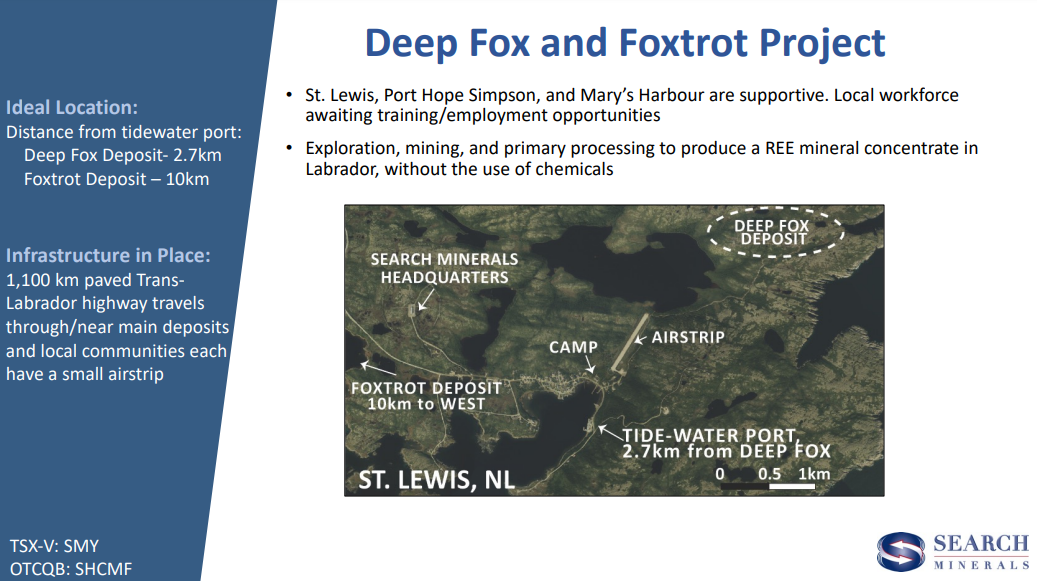North American Rare Earth Juniors Consolidate Capabilities to Advance Towards a Total Domestic Supply Chain
There were otherwise unrelated announcements last week, but, with a common purpose, by separate pairs of rare earth juniors: The common purpose was the advancing of the creation of a domestic American rare earth enabled product(s) total supply chain.
In one case the Canadian rare earth Junior miner, Search Minerals Inc. (TSXV: SMY | OTCQB: SHCMF), entered into a non-binding MOU for the future delivery of a rare earth mineral concentrate supply, containing 500 tpa of Neodymium/Praseodymium, with one of its investors, privately owned, USA Rare Earth LLC , which has committed itself to producing commercial tonnages of rare earth permanent magnets in the United States as early as 2022-23. Another announcement was made by the Canadian rare earth junior critical metals’ processor, Ucore Rare Metals Inc. (TSXV: UCU | OTCQX: UURAF | FSE: U9U), which announced that it had entered into an MOU with Australia’s Vital Metals Ltd. (ASX: VML | OTCMKTS: VTMXF ): for a supply of rare earth ore concentrates from Vitals’ already underway mining operations in Canada’s Northwest Territory, to be first processed into a mixed rare earth carbonate in a facility funded by Canada’s Saskatchewan Research Council in Saskatoon, Saskatchewan, and then shipped to Ucore’s proposed Strategic Metals (processing) Center in Ketchikan, Alaska, USA, for separation into individual rare earths.
These announcements are indicative of a sea-change in the thinking of an increasing number of non-Chinese junior rare earth companies. In the last rare earth boom from 2007-2012 hundreds of juniors had the same goal, the production and sale of a “mixed con” of rare earths, in other words, of an ore concentrate or a concentrate of mixed rare earth solids prepared by hydrometallurgical treatment of ore concentrates. It was commonly believed at that time that Chinese rare earth separation companies, then the only customers, would pay 65% of the ”basket value,” defined as the market price of separated versions of the rare earths contained in the mixed concentrate. This was magical thinking based on a complete misunderstanding of the value of, and the markets for, either ore concentrates or mixed rare earth concentrates. Even today some juniors still insist that their ore concentrates have a basket value based on the values of finished goods. Chinese separators typically have offered 40% of the basket value, delivered into China for high grade ore concentrates free of elements that interfere with solvent extraction separation of mixed rare earths.
The ”supply chain crisis” has clarified the thinking of many juniors. They realize that their product must have an immediate determinable-price demand and that this demand must be by processors who add enough value, so that they can afford to buy the junior’s product at a price that allows the junior to make a profit. This may seem trivially obvious, but it was blithely overlooked in the 2007-12 rare earth boom.
A new factor has entered the calculus for determining the price of mixed rare earth ore concentrates or of mixed rare earth solids free of both radioactive and of SX interfering contaminants. That factor is any added value governments and industries are willing to pay for non-Chinese, or domestic, materials of these descriptions.
So far, only one non-Chinese vendor has entered the market with mixed rare earth carbonate (solids) free of radioactive and SX interferents. That is America’s Energy Fuels Inc. (NYSE American: UUUU | TSX: EFR), which is processing non-Chinese monazite ore at its White Mesa, Utah, uranium processing mill. The mixed rare earth carbonate solids are being sold, at a profit to Energy Fuels, to Canada’s Neo Performance Materials Inc. (TSX: NEO | OTCMKTS: NOPMF), which has them delivered to its rare earth separation facility in Estonia, where the material is separated into individual rare earths for further processing by Neo or its customers into rare earth permanent magnets, phosphors, ceramic additives, and other fine chemicals. The European Union is already well ahead of the USA in organizing a financial facility to underwrite the creation of a European domestic rare earth enabled products total supply chain without Chinese participation at any level.
In the United States and Canada the supply chain issue is downstream of mining, and is manifested in the total lack of commercial facilities for rare earth separation, metal and alloy making, magnet making, and end use manufacturing.
Europe has existing facilities for up to 12,000 tpa of rare earths separation, a thousand tpa of rare earth metals and alloys, and substantial capacity and existing expertise to make rare earth permanent magnets of the most widely used, sintered, type. Further, both the UK and the EU governments have already begun to support the expansion of existing rare earth processors financially.
The United States and Canada should take a lesson from the UK and the EU: Get industrial end users involved from the very beginning. The UK and the EU speak with industrial experts as well as academics and bureaucrats. The difference is really beginning to show.








